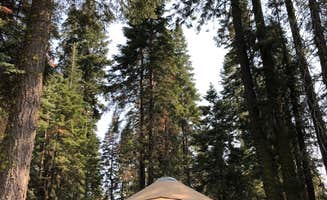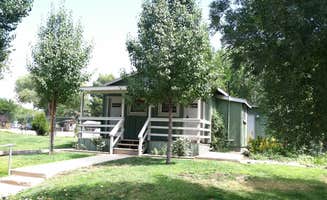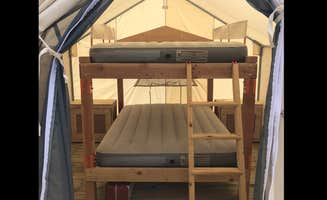The Sequoia National Forest region surrounding Porterville sits at elevations between 1,000 and 7,000 feet, creating diverse camping microclimates across multiple ecological zones. Summer temperatures in lower elevation campgrounds regularly exceed 90°F, while higher elevation sites remain 15-20 degrees cooler. Canvas glamping accommodations near Porterville, California typically operate seasonally from May through October due to winter snowfall at higher elevations.
What to do
Hike to giant sequoia groves: The Trail of 100 Giants crosses from Redwood Meadow campground, offering an accessible 1.5-mile round-trip trail. "This is a tourist stop. You've been warned. And with a name as cool as 'Trail of 100 Giants' plenty of people who are outdoorsy just enough will make the trip," notes Ryan W., who recommends visiting during weekdays to avoid crowds.
Cool off in river swimming areas: During summer months, the Kern River provides relief from heat at Camp Three Campground. "Take a 3 minute walk through the woods to get to Kern River and you have a little oasis away from it all," writes Mike N. The riverside sites offer designated swimming spots: "From these gems, the river is just a short, 1 or 2 minute walk to the River."
Stargaze at higher elevations: When air quality permits, the higher elevation campgrounds offer exceptional night skies. At Horse Creek Campground, Cliff K. reports, "The stargazing is beautiful. There is some limited light pollution emanating from the other side of the foothills, but because you are surrounded by foothills you get some good, dark surroundings to really appreciate the stars."
What campers like
River access for water activities: At KRS RV Resort@Camp James, the river proximity allows for tubing and swimming. "We were able to float down the river in our inner tubes safely. We were told May to June the river is very high in this area," writes David H., noting it was perfect for his family with a 5-year-old.
Wildlife viewing opportunities: Sequoia National Forest camping areas offer diverse wildlife encounters. At Quaking Aspen Campground, visitors report, "We had a trail camera set up all night every night and caught nothing," while others note ground squirrels and birds. Kim L. mentions, "no food lockers, but also no in-camp bear incidents/sightings in the last few years."
Shaded campsites: Mature trees throughout many campgrounds provide essential summer cooling. At Kern River County Park, Kevin notes, "Any of the covered spots are truly shaded by trees making a mid day snooze very doable," while another camper describes the "well-spaced sites, you never feel like you're in your neighbor's lap."
What you should know
Seasonal facility limitations: Glamping close to Porterville requires planning for facility changes. At Sequoia National Forest Quaking Aspen Campground, Stan H. encountered challenges: "The non yurt sites didn't have bear lockers. Fire ring was in rough shape," and notes "Ponderosa general store was going to be my go-to for firewood but it had burned down."
Limited cell service: Most forest campgrounds have minimal connectivity. Kim L. reports from Quaking Aspen: "If you want cell service briefly, there is a spot about 3.5 miles away off 21S70 as if you're headed to Dome rock," while others note complete disconnection.
Variable water availability: Water access varies by location and season. At Horse Creek Campground, fabricio M. observed, "The drought have made it too far to my liking we had to drive 3 miles up where the river flows to cool down," while at Redwood Meadow, Ryan W. warns, "recreation.gov and reserveamerica.com both list this campground as having water. That is NOT TRUE."
Tips for camping with families
Choose sites with swimming access: For family-friendly glamping near Porterville, California, prioritize water features. At Sunset Campground, Michael D. observed, "Large boulders and huge fallen trees provided plenty of places to sit or bask in the sun," while nearby Hume Lake offers additional swimming.
Consider proximity to bathrooms: At Camp Three, Kim explains site selection strategy: "While nice to be near the water spouts and bathrooms, we would not recommend sites (#3-19, #22, #24, #26). Further down the river, we noticed that sites opened up a bit more and had much more space and shade, AND that the river was a lot closer - all great for larger groups and especially those with children."
Pack for temperature swings: Mountain elevation causes significant day-night temperature differences. At Buckeye Flat Campground, Sam M. advises, "The sites are tent only, so no hookups or anything like that. Pretty nice sites though, a lot of space," noting wildlife viewing opportunities for kids while cautioning about bear awareness.
Tips from RVers
Check site accessibility before booking: At Buckeye Flat Campground, James W. encountered challenges: "It would have been a good site for a tent but we are traveling with a roof tent. Our site was a bit uneven with no way to level it." Many forest campgrounds have narrow roads and limited turnaround space.
Consider full hookup alternatives: For RVers seeking amenities while glamping near Porterville, Visalia-Sequoia National Park KOA offers more developed options. At Lindy's Landing, Scott M. reports improvements: "We had camped here about 10-15 years ago and found the park to be a bit dusty, dry, and run down. This time it was very green, very shady, and well kept."
Use designated dump stations: Many forest campgrounds lack sewer connections. At Horse Creek Campground, Connor N. notes, "Bathrooms were messy and half were out of order due to a maintenance project. The RV Dump station was also unavailable," highlighting the importance of calling ahead to confirm facility status.





